 Global| Apr 14 2010
Global| Apr 14 2010U.S. CPI Increase Is Weak; CorePrices Are Unchanged
by:Tom Moeller
|in:Economy in Brief
Summary
Consumer price inflation remain subdued last month, according to the U.S. Bureau of Labor Statistics. It reported that the CPI during March rose all of 0.1% after having been unchanged during February. That was enough to leave the [...]
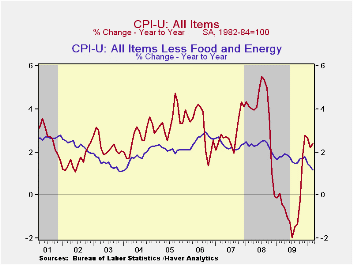
Consumer price inflation remain subdued last month, according to the U.S. Bureau of Labor Statistics. It reported that the CPI during March rose all of 0.1% after having been unchanged during February. That was enough to leave the change during the last three months at 0.9% (AR), its lowest since May of last year. The latest figure matched Consensus expectations.
Core consumer prices also were weak. Goods & services together were unchanged while a 0.1% increase had been expected. That pulled the three-month change to negative 0.1% which was its lowest since January 2009. Core goods prices fell 0.1% as they did in February. That was enough to pull the three-month gain to a negative 0.1% versus the high of 5.4% last April. New & used motor vehicles prices posted a 0.2% increase (5.5% y/y). Apparel prices began to fall slightly versus last year while prices for household furnishings & operation fell 2.3% y/y.
Core services prices again inched up 0.1% (+0.9% y/y). Weakness in the housing market caused a 0.5% y/y decline in shelter prices while owners equivalent rent of primary residences, a measure not equivalent to other house price measures, slipped again m/m. A slight y/y decline in this measure was the weakest reading since the series' start in 1983. Elsewhere in services, prices have been relatively strong. Public transportation prices rose 0.5% (6.1% y/y) and medical care services prices gained another 0.3% (3.8% y/y). Finally, education costs posted a strong 0.6% increase (4.9% y/y) but recreation prices slipped for the seventh straight month (-1.1% y/y).
Energy prices slipped slightly again as they reflected a 0.8% m/m decline in gasoline prices. Gas prices are up, however, by 41.4% y/y. Fuel oil prices slipped 1.3% (+19.6% y/y) but natural gas & electricity prices rose a firm 1.4% (-1.8% y/y).
Food & beverage prices firmed a bit by 0.2% but the y/y gain of 0.3% followed six months of price deflation. A 0.4% decline in dairy prices was an improvement from the 10.4% decline last summer. Also showing less deflation were prices for meats, poultry, fish & eggs (-1.7% y/y) but cereal & bakery product prices continued weak (-1.1% y/y). Dairy product prices also showed less deflation (-0.4% y/y) while fruit & bakery products rose 2.1% y/y. Finally, the cost of eating out rose just 1.2%, a record low increase, while alcoholic beverage prices also rose just 1.1% y/y, the least since 1995.
The chained CPI, which adjusts for shifts in consumption patterns improved last month and rose 2.5% year-to-year. Chained prices less food & energy gained 0.8% y/y.
The consumer price data is available in Haver's USECON database while detailed figures can be found in the CPIDATA database.
Has the behavior of inflation and long-term inflation expectations changed? from the Federal Reserve Bank of Kansas City can be found here.
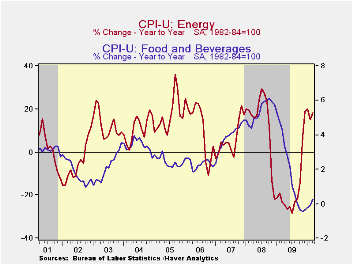
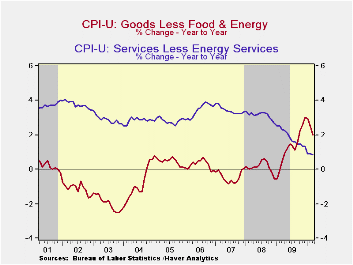
| Consumer Price Index (%) | March | February | January | March y/y | 2009 | 2008 | 2007 |
|---|---|---|---|---|---|---|---|
| Total | 0.1 | 0.0 | 0.2 | 2.4 | -0.3 | 3.8 | 2.9 |
| Total less Food & Energy | 0.0 | 0.1 | -0.1 | 1.2 | 1.7 | 2.3 | 2.3 |
| Goods less Food & Energy | -0.1 | -0.1 | 0.1 | 2.0 | 1.3 | 0.1 | -0.4 |
| Services less Energy | 0.1 | 0.1 | -0.2 | 0.9 | 1.9 | 3.1 | 3.4 |
| Energy | -0.0 | -0.5 | 2.8 | 14.9 | -18.1 | 13.7 | 5.6 |
| Food & Beverages | 0.2 | 0.0 | 0.2 | 0.3 | 1.9 | 5.4 | 3.9 |
| Chained CPI: Total (NSA) | 0.4 | -0.0 | 0.4 | 2.5 | -0.1 | 3.7 | 2.5 |
| Total less Food & Energy | 0.2 | 0.2 | -0.0 | 0.8 | 1.5 | 2.0 | 1.9 |
by Robert Brusca April 14, 2010
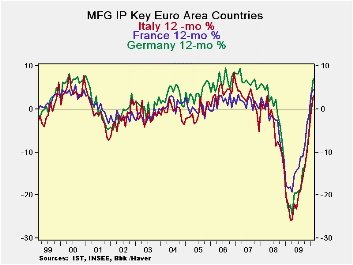
Even with that strong-seeming chart and rock solid 0.9% gain in February, manufacturing IP in the Zone remains some 14% below it past cycle peak. But eh current progress looks good as growth over 3-and 6-months have average a pace of 19%. The consumer sector continues to lag with a three-month growth rate of 2.2%.
Among large Euro-Area member countries Spain grew the strongest in Feb, but it is a volatile report from Spain that fell by 3.4% in January, undercutting the impact of the gain in February. The UK, an EU member, had the next strongest gain among large European economies at 1.3% but that was a recoup from a -0.9% result in January. Italy with a 0.2% rise on the heels of a 1.7% gain has the best two-month result followed by Germany at 0.2% and 0.6%, in Feb and Jan, respectively. Still, both Germany and Spain show IP contractions over three-months. Spain’s output is still falling over 12-months but over 12-months German IP is up by 7.1%., followed by France at 3.3% Italy at 3% and the UK at 1.5%.
The February gains were on the back of a spike in intermediate goods output which advanced by 1.5%. Capital goods output rose by 0.9%. The consumer categories receded. Europe needs to get its consumer in gear. Europe, like many countries is trying to let its export sector pull it out of its recessionary hole almost all by itself. This is imbalanced growth that leans heavily on demand with origins elsewhere. Europe needs to learn to stand on its own two feet.
| Euro-Area MFG IP | ||||||||||||||||||||||||||||||||||||||||||||||||||||||||||||||||||||||||||||||||||||||||||||||||||||||||||||||
|---|---|---|---|---|---|---|---|---|---|---|---|---|---|---|---|---|---|---|---|---|---|---|---|---|---|---|---|---|---|---|---|---|---|---|---|---|---|---|---|---|---|---|---|---|---|---|---|---|---|---|---|---|---|---|---|---|---|---|---|---|---|---|---|---|---|---|---|---|---|---|---|---|---|---|---|---|---|---|---|---|---|---|---|---|---|---|---|---|---|---|---|---|---|---|---|---|---|---|---|---|---|---|---|---|---|---|---|---|---|---|
| Saar except m/m | Mo/Mo | Feb 10 |
Jan 10 |
Feb 10 |
Jan 10 |
Feb 10 |
Jan 10 |
|||||||||||||||||||||||||||||||||||||||||||||||||||||||||||||||||||||||||||||||||||||||||||||||||||||||
| Euro-Area Detail | Feb 10 |
Jan 10 |
Dec 09 |
3Mo | 3Mo | 6mo | 6mo | 12mo | 12mo | Q-4 | ||||||||||||||||||||||||||||||||||||||||||||||||||||||||||||||||||||||||||||||||||||||||||||||||||||
| MFG | 0.9% | 1.3% | 0.3% | 10.6% | 12.6% | 10.1% | 9.0% | 4.2% | 0.9% | 12.3% | ||||||||||||||||||||||||||||||||||||||||||||||||||||||||||||||||||||||||||||||||||||||||||||||||||||
| Consumer | -0.3% | 0.5% | 0.3% | 2.2% | 9.1% | 1.2% | 2.2% | 1.1% | -0.1% | 5.1% | ||||||||||||||||||||||||||||||||||||||||||||||||||||||||||||||||||||||||||||||||||||||||||||||||||||
| C-Durables | -0.6% | 2.6% | -1.5% | 1.4% | 12.2% | 7.3% | 10.5% | -0.3% | -2.5% | |||||||||||||||||||||||||||||||||||||||||||||||||||||||||||||||||||||||||||||||||||||||||||||||||||||
| C-Non-durables | -0.2% | 0.3% | 0.6% | 2.8% | 7.5% | 3.1% | 1.3% | 1.5% | 0.6% | |||||||||||||||||||||||||||||||||||||||||||||||||||||||||||||||||||||||||||||||||||||||||||||||||||||
| Intermediate | 1.5% | 0.8% | -1.1% | 4.6% | 1.8% | -4.2% | 6.2% | 6.9% | 3.6% | 5.1% | ||||||||||||||||||||||||||||||||||||||||||||||||||||||||||||||||||||||||||||||||||||||||||||||||||||
| Capital | 0.9% | -1.1% | 0.0% | -0.7% | 1.5% | 4.5% | 5.9% | 3.1% | -0.8% | -0.7% | ||||||||||||||||||||||||||||||||||||||||||||||||||||||||||||||||||||||||||||||||||||||||||||||||||||
| Main Euro-Area Countries and UK IP in MFG | ||||||||||||||||||||||||||||||||||||||||||||||||||||||||||||||||||||||||||||||||||||||||||||||||||||||||||||||
| Mo/Mo | Feb10 | Jan10 | Feb10 | Jan10 | Feb10 | Jan10 | ||||||||||||||||||||||||||||||||||||||||||||||||||||||||||||||||||||||||||||||||||||||||||||||||||||||||
| MFG Only | Feb 10 |
Jan 10 |
Dec 09 |
3Mo | 3Mo | 6mo | 6mo | 12mo | 12mo | Q:4 Date |
||||||||||||||||||||||||||||||||||||||||||||||||||||||||||||||||||||||||||||||||||||||||||||||||||||
| Germany: | 0.2% | 0.6% | -1.3% | -2.1% | 1.3% | 4.5% | 8.7% | 7.1% | 3.2% | -3.1% | ||||||||||||||||||||||||||||||||||||||||||||||||||||||||||||||||||||||||||||||||||||||||||||||||||||
| France: IPxConstruct'n |
0.0% | 1.1% | -0.3% | 3.2% | 6.9% | 0.7% | 5.3% | 3.3% | 2.6% | 4.1% | ||||||||||||||||||||||||||||||||||||||||||||||||||||||||||||||||||||||||||||||||||||||||||||||||||||
| Italy | 0.2% | 1.7% | -0.6% | 5.3% | 6.8% | 7.6% | 3.8% | 3.0% | -0.6% | 5.3% | ||||||||||||||||||||||||||||||||||||||||||||||||||||||||||||||||||||||||||||||||||||||||||||||||||||
| Spain | 1.6% | -3.4% | -0.6% | -9.3% | -15.4% | -11.9% | -7.3% | -2.1% | -2.0% | -9.9% | ||||||||||||||||||||||||||||||||||||||||||||||||||||||||||||||||||||||||||||||||||||||||||||||||||||
| UK: EU member | 1.3% | -0.9% | 0.9% | 5.5% | 0.5% | 6.3% | -0.7% | 1.5% | 0.1% | 3.3% | ||||||||||||||||||||||||||||||||||||||||||||||||||||||||||||||||||||||||||||||||||||||||||||||||||||
by Tom Moeller April 14, 2010
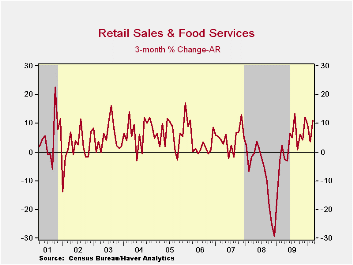
Forward momentum is building behind consumer spending. March retail sales rose 1.6%; triple the upwardly revised readings of the prior two months and stronger than the 1.2% increase that had been expected. On a three-month basis sales rose at an 11.0% annual rate. Nonauto sales rose 0.6% but the February increase also was revised up to 1.0% after an upwardly revised 0.6% January increase. The latest gain was near expectations. On a three-month basis the gain in nonauto sales remained strong at 9.3% (AR). These numbers were, of course, helped by moderation in gasoline prices. Nonauto retail sales less gasoline, a better measure of "core" spending, grew 0.7% last month and at a 10.2% annual rate during the last three, the strongest since January 2006.
"Core" discretionary spending improved. Apparel store sales rose 2.3% during March and at a 22.1% annual rate during the last three months. General merchandise store sales also rose a firm 0.6% and at a 11.9% three-month rate. Sales at furniture, home furnishings & electronics stores lagged these gains last month. They were unchanged but were up at a 9.8% annual rate over the last three months. That's improved from the 9.6% decline during all of last year. Furniture sales alone have been rising at a 14.5% rate while sales of electronics & appliances have been rising at a 15.4% rate.
Mirroring the improvement in unit sales, motor vehicle sales improved considerably by 6.6% last month and at a 19.8% rate during the last three. Finally, growth in sales at gasoline service stations fell 0.4% and rose at just a 2.7% rate during the last three months.
Earlier strength in internet & catalogue sales continued to ease. Sales ticked up just 0.2% and the three-month rate of gain backed off to 7.3%, one third the growth earlier this year.
The retail sales data are available in Haver's USECON database
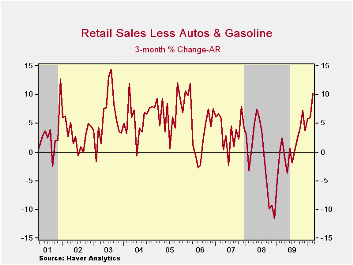
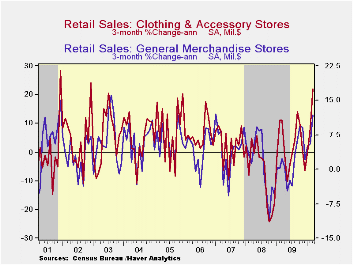
| March | February | January | March Y/Y | 2009 | 2008 | 2007 | |
|---|---|---|---|---|---|---|---|
| Total Retail Sales & Food Services (%) | 1.6 | 0.5 | 0.5 | 7.6 | -6.0 | -0.8 | 3.3 |
| Excluding Autos | 0.6 | 1.0 | 0.6 | 6.4 | -4.8 | 2.4 | 3.9 |
| Non-Auto Less Gasoline | 0.7 | 1.1 | 0.6 | 4.2 | -1.9 | 1.6 | 3.6 |
by Tom Moeller April 14,2010
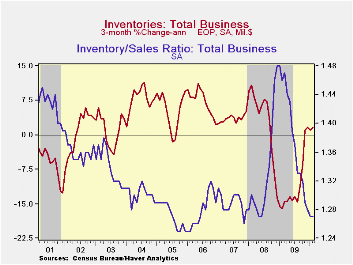
Business inventories have resumed the trend toward modest accumulation. During February, a 0.5% increase was the strongest of four in the last five months. The gains follow 9.8% decumulation during all of 2009 and the recent increases are the first since mid-2008. Nevertheless, the increases have not kept up with improvement in sales and the I/S ratio remained at its low of 1.27.
Retail inventories have started to rise. The 0.3% February gain was third modest increase following sharp declines during 2008 & 2009. That accumulation owes, however, to the auto sector where inventories have been accumulating since September. Less autos, the rate of decumulation only has slowed to 4.1% y/y from the peak decumulation rate of 7.7% last fall. The slowdown has been led by furniture stores and general merchandise but apparel store inventories still are falling at near their strongest rate of 10.2% y/y.
Inventory accumulation in the factory sector compares with sharp decumulation through most of 2009. It has been accompanied by higher wholesale inventories, but here the improvement has been raised by higher oil prices. Less oil, wholesale inventories still are being shed at a 9.5% rate versus the 12.5% decline during all of last year.
The business sales and inventory data are available in Haver's USECON database.
Inventories, inflation dynamics, and the New Keynesian Phillips Curve from the Federal Reserve Bank of Richmond is available here.
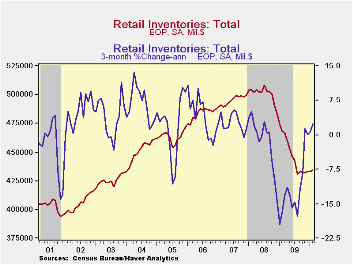
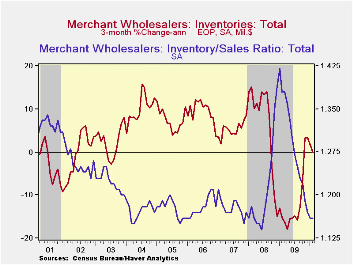
| Business Inventories (%) | February | January | December | Feb. y/y | 2009 | 2008 | 2007 |
|---|---|---|---|---|---|---|---|
| Total | 0.5 | 0.2 | -0.2 | -6.7 | -9.8 | 0.8 | 4.0 |
| Retail | 0.3 | 0.1 | 0.2 | -7.2 | -10.4 | -3.3 | 2.5 |
| Retail excl. Auto | -0.1 | -0.2 | 0.4 | -4.1 | -4.9 | -1.9 | 2.7 |
| Wholesale | 0.6 | 0.1 | -0.8 | -7.4 | -10.5 | 3.7 | 6.4 |
| Manufacturing | 0.5 | 0.3 | -0.2 | -5.6 | -8.7 | 2.2 | 3.7 |
Tom Moeller
AuthorMore in Author Profile »Prior to joining Haver Analytics in 2000, Mr. Moeller worked as the Economist at Chancellor Capital Management from 1985 to 1999. There, he developed comprehensive economic forecasts and interpreted economic data for equity and fixed income portfolio managers. Also at Chancellor, Mr. Moeller worked as an equity analyst and was responsible for researching and rating companies in the economically sensitive automobile and housing industries for investment in Chancellor’s equity portfolio. Prior to joining Chancellor, Mr. Moeller was an Economist at Citibank from 1979 to 1984. He also analyzed pricing behavior in the metals industry for the Council on Wage and Price Stability in Washington, D.C. In 1999, Mr. Moeller received the award for most accurate forecast from the Forecasters' Club of New York. From 1990 to 1992 he was President of the New York Association for Business Economists. Mr. Moeller earned an M.B.A. in Finance from Fordham University, where he graduated in 1987. He holds a Bachelor of Arts in Economics from George Washington University.






